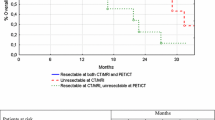Abstract
Background
Recent data confirmed the importance of 18-fluoro-2-deoxy-d-glucose positron emission tomography (FDG-PET) in the selection of patients with colorectal hepatic metastases for surgery. Neoadjuvant chemotherapy before hepatic resection in selected cases may improve outcome. The influence of chemotherapy on the sensitivity of FDG-PET and CT in detecting liver metastases is not known.
Methods
Patients were assigned to either neoadjuvant treatment or immediate hepatic resection according to resectability, risk of recurrence, extrahepatic disease, and patient preference. Two-thirds of them underwent FDG-PET/CT before chemotherapy; all underwent preoperative contrast-enhanced CT and FDG-PET/CT. Those without extensive extrahepatic disease underwent open exploration and resection of all the metastases according to original imaging findings. Operative and pathological findings were compared to imaging results.
Results
Twenty-seven patients (33 lesions) underwent immediate hepatic resection (group 1), and 48 patients (122 lesions) received preoperative neoadjuvant chemotherapy (group 2). Sensitivity of FDG-PET and CT in detecting colorectal (CR) metastases was significantly higher in group 1 than in group 2 (FDG-PET: 93.3 vs 49%, P < 0.0001; CT: 87.5 vs 65.3, P = 0.038). CT had a higher sensitivity than FDG-PET in detecting CR metastases following neoadjuvant therapy (65.3 vs 49%, P < 0.0001). Sensitivity of FDG-PET, but not of CT, was lower in group 2 patients whose chemotherapy included bevacizumab compared to patients who did not receive bevacizumab (39 vs 59%, P = 0.068).
Conclusions
FDG-PET/CT sensitivity is lowered by neoadjuvant chemotherapy. CT is more sensitive than FDG-PET in detecting CR metastases following neoadjuvant therapy. Surgical decision-making requires information from multiple imaging modalities and pretreatment findings. Baseline FDG-PET and CT before neoadjuvant therapy are mandatory.
Similar content being viewed by others
References
Kemeny N, Fong Y. Treatment of liver metastases. Cancer Medicine. Baltimore: Williams and Wilkins, 1997, pp 1939–1954.
Fortner JG, Silva JS, Golbey RB, et al. Multivariate analysis of a personal series of 247 consecutive patients with liver metastases from colorectal cancer. 1. Treatment by hepatic resection. Ann Surg 1984;199:306–316.
Adson MA, Van Heerden JA, Adson MH, et al. Resection of hepatic metastases from colorectal cancer. Arch Surg 1984;11: 647–651.
Hughes KS, Simon R, Soughourabodi S, et al. Resection of the liver for colorectal carcinoma metastases: a multi institutional study of patterns of recurrence. Surgery 1986;100:278–284.
Scheele J, Strangl R, Altendorf-Hofmann A, et al. Resection of colorectal liver metastases. World J Surg 1985;19:59–71.
Scheele J, Strangl R, Altendorf-Hofmann A, et al. Indicators of prognosis after hepatic resection for colorectal secondaries. Surgery 1991;11:13–29.
Gibbs JF, Weber TK, Rodriguez-Bigas MA, et al. Intraoperative determinants of unresectability for patients with colorectal hepatic metastases. Cancer 1982;82:1244–1249.
Steele G, Bleday R, Mayer RJ. A prospective evaluation of hepatic resection for colorectal carcinoma metastases to the liver: gastrointestinal tumor study group protocol 6584. J Clin Oncol 1991;9:1105–1112.
Valk PE, Abella-Columna E, Haesman MK, et al. Whole body PET imaging with [18F]fluorodeoxyglucose in management of recurrent colorectal cancer. Arch Surg 1999;134:503–511.
Delbeke D, Vitola JV, Sandler MP, et al. Staging recurrent metastatic colorectal carcinoma with PET. J Nucl Med 1997; 38:1196–1201.
Abdel-Nabi H, Doerr RJ, Lamonica DM, et al. Staging of primary colorectal carcinomas with fluorine-18 fluorodeoxyglucose whole body PET: correlation with histopathologic and CT findings. Radiology 1998;206:755–760.
Vitola JV, Delbeke D, Sandler MP, et al. PET to stage suspected metastatic colorectal carcinoma to the liver. Am J Surg 1996; 171:21–26.
Flamen P, Stroobants S, Van-Cutsem E, et al. Additional value of whole-body PET with fluorine-18-2fluoro-2-deoxy-D-glucose in recurrent colorectal cancer. J Clin Oncol 1999;17:894–901.
Fernandez F, Drebin JA, Linehan DC, et al. Five year survival after resection of hepatic metastases from colorectal cancer in patients screened by positron emission tomography with 18-f fluorodeoxyglucose (FDG-PET). Ann Surg 2004;240:438–450.
Bismuth H, Adam R, Levi F, et al. Resection of nonresectable liver metastasis from colorectal cancer after neoadjuvant chemotherapy. Ann Surg 1996;224:509–522.
Adam R. Chemotherapy and surgery: new perspectives on the treatment of unresectable liver metastases. Ann Oncol 2003;14(Suppl 2):ii13–ii16.
Tanaka K, Adam R, Shimada H, et al. Role of neoadjuvant chemotherapy in the treatment of multiple colorectal metastases to the liver. Br J Surg 2003;90:963–969.
Allen PJ, Kemeny N, Jarnagin W, et al. Importance of response to neoadjuvant chemotherapy in patients undergoing resection of synchronous colorectal liver metastases. J Gastrointest Surg 2003;7:109–117.
Fong Y, Fortner J, Sun RL, et al. Clinical score for predicting recurrence after hepatic resection for metastatic colorectal cancer. Ann Surg 1999;230:309–321.
Ruers TJM, Langenhoff BS, Neelman N, et al. Value of positron emission tomography with [f-18]fluorodeoxyglucose in patients with colorectal liver metastases: a prospective study. J Clin Oncol 2002;20:388–395.
Kostakoglu L, Goldsmith SJ. 18F-FDG PET evaluation of the response to therapy for lymphoma and for breast, lung, and colorectal carcinoma. J Nucl Med 2003;44:224–239.
Whitford MH, Yee LF, Ogunbiyi OA, et al. Usefulness of FDG-PET scan in the assessment of suspected metastases or recurrent adenocarcinoma of the colon and rectum. Dis Colon Rectum 2000;43:759–767.
Nguyen M, Varma V, Perez R, et al. CT with histopathologic correlation of FDG uptake in a patient with pulmonary granuloma and pleural plaque caused by remote talc pleurodesis. AJR Am J Roentgenol 2004;182:92–94.
Acknowledgment
Esther Eshkol is thanked for editorial assistance.
Conflict of interest statement
None declared
Author information
Authors and Affiliations
Corresponding author
Additional information
The abstract was presented before the 58th Cancer Symposium of the Society of Surgical Oncology, Atlanta, GA, USA, 2005, and before the 2005 Congress of the American Hepato-Pancreato-Biliary Association, Fort-Lauderdale, FL, USA.
Rights and permissions
About this article
Cite this article
Lubezky, N., Metser, U., Geva, R. et al. The Role and Limitations of 18-Fluoro-2-deoxy-d-glucose Positron Emission Tomography (FDG-PET) Scan and Computerized Tomography (CT) in Restaging Patients with Hepatic Colorectal Metastases Following Neoadjuvant Chemotherapy: Comparison with Operative and Pathological Findings. J Gastrointest Surg 11, 472–478 (2007). https://doi.org/10.1007/s11605-006-0032-8
Published:
Issue Date:
DOI: https://doi.org/10.1007/s11605-006-0032-8




